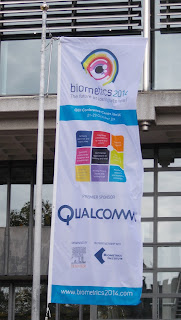I was the first. My first bore no comparison. I made my way
through the vast open space. I headed up into the eerie purple light, before
emerging into another vast open space.
It was a strange experience to make my way - on my own -
through London's Science Museum. I had just visited the new Cosmonauts Exhibition
after normal opening hours.
First woman cosmonaut
A vast photo of the first woman in space looked down on the
IMAX auditorium. I had just seen the unbelievably tiny "pod" in which Valentina Tereshkova had bravely ventured into space in 1963.
Even Valentina's mother hadn't known about her space
mission. She had believed that her daughter was just on parachute training. Can
you imagine finding out that your daughter was the first woman in space from
the TV? She was present when Valentina collected a bravery medal afterwards.
Science Museum Talk
Broadcaster Helen Keen hosted a talk at the Science Museum
on "Women in Space" on 23rd October. Her guests were the French
cosmonaut, Claudie Haigneré and British Flight Director, Libby Jackson. Both
women have had extraordinarily inspirational careers. As Valentina Tereshova
said:
"A Bird cannot fly with one wing only.
Human space flight cannot develop any further
without the active participation
of women".
Claudie Haigneré
When Neil Armstrong landed on the moon, Claudie Haigneré was
12 years' old. She was camping on her summer holiday. She marvelled at the moon
in the sky. The inaccessible dream had become a reality. In the absence of any
European space opportunities, Claudie embarked on a career in medicine.
In 1985, Claudie saw an advertisement for cosmonauts with a
scientific background. She jumped at the chance. Only 10 women applied. Only 7
candidates were selected from 1,000 applicants: 3 pilots, 4 scientists.
Claudie became the only female cosmonaut training at Star
City. She paved her own way. She didn't dwell on being the only woman in a
male-dominated field. The more appreciable difference is between a military and
civilian role.
Libby Jackson
Libby Jackson showed a similar go-getting attitude. She had
always been interested in space. Her earliest memory was of the Challenger
Disaster. At 17, she had the nerve to ask to shadow a NASA flight director in
Huston, Texas. If you don't ask, you don't get! She saw NASA's moon rocks and
thought "this is me".
There were no Brits employed at NASA back then. She had to forget the idea.
There were no Brits employed at NASA back then. She had to forget the idea.
Libby studied Physics at university. She headed for Munich
when she first became aware of the space industry there. She always made people
aware of what she wanted to do. She is now delighted with her role as Flight
Director at the UK's Space Agency in Swindon.
Libby is very excited about her involvement in Tim Peake's Principia mission in the International Space Station (ISS). The launch date is not far away on 15 December 2015.
Libby is very excited about her involvement in Tim Peake's Principia mission in the International Space Station (ISS). The launch date is not far away on 15 December 2015.
 |
| Left to right: Libby Jackson, Helen Keen and Claudie Haigneré |
Women in STEM
The two women debated how there has not generally been
enough progress. Women are not
putting themselves forward. There are still not enough women studying STEM
subjects.
It is important for women like Claudie and Libby to share
both the technical and human adventure of their stories. Claudie found living
in a multicultural environment incredibly enriching for her life and career. Libby
similarly spreads the message by visiting schools.
There is no need to act like a man. NASA achieves its best
results in mixed teams. Libby stressed that the UK Space Agency employs 44
women and 34 men.
Future missions
Only 500 astronauts have ever travelled into space. Yet,
there are countless ground support roles. A Mars mission is a very distant
prospect with the journey taking 6-9 months. Revisiting the moon is more
likely. A mission's success is the focus of the whole team whether male or
female.
Claudie would welcome a mission to the moon. Mars is for the
next generation of astronauts. Her funniest story was of a phone call from
space. Her daughter claimed she was too busy to take the call, as if her mother
was just around the corner.
Impatience
A member of the audience asked about fear. Claudie replied
that impatience was the greatest emotion after 5 years for her PhD and 10 years
of training.
Libby confirmed that the British astronaut, Tim Peake feels
the same way. He is more nervous about missing out after all the
training and build-up.
Britons in space
He won't be the first Briton in space. That honour went to
a British woman, Helen Sharman in 1991. Six male British citizens followed her.
Inspiring a new generation
You can see the Principia mission's countdown ticking away on the European
Space Agency's website. Maybe the mission will inspire a whole new generation of
female astronauts and flight directors?
For further information about Anglicity's content writing services, email karen@anglicity.com.
For further information about Anglicity's content writing services, email karen@anglicity.com.








